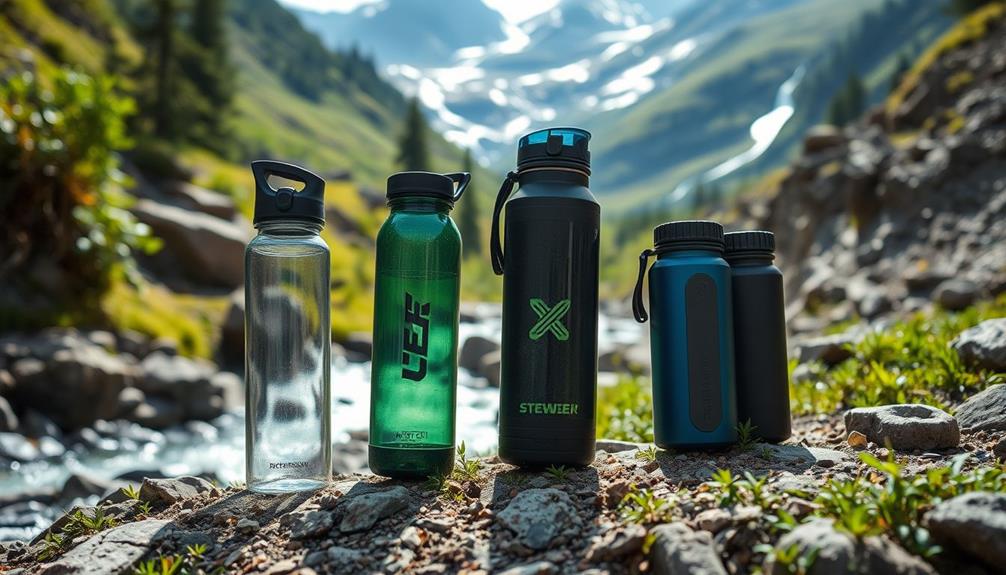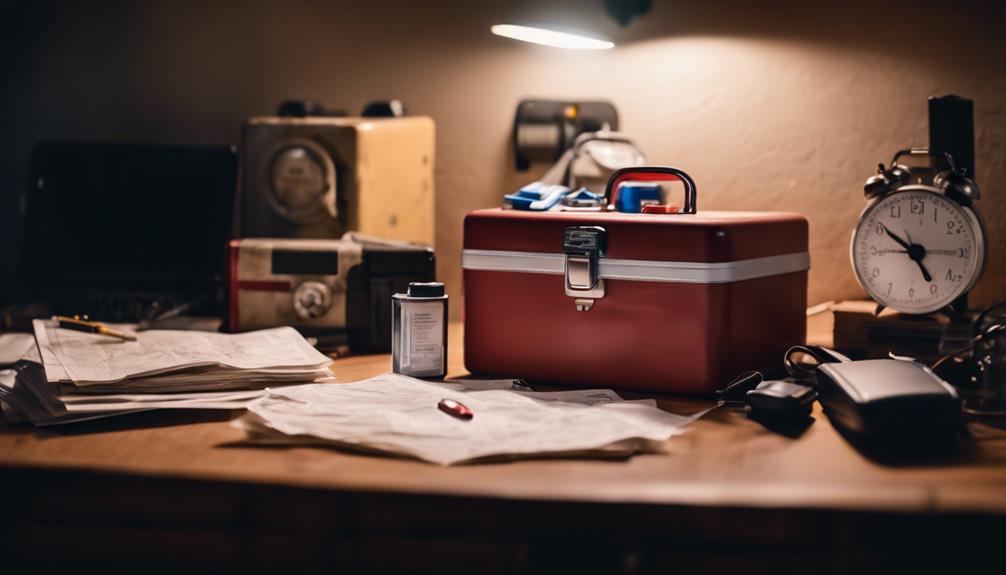Preparing your INCH bag is essential for long-term survival in emergencies. Start by packing reliable gear like a sturdy family-sized tent, insulated sleeping bags, and a multi-tool for various tasks. Include a water filtration system for safe drinking, as well as freeze-dried meals and survival seeds for food sustainability. Don't forget comfort items like a lightweight blanket and a ground tarp. Make certain to customize your bag based on your location and family needs. Regularly test and update your supplies to guarantee everything remains effective. You'll discover more about fine-tuning your survival strategy as you explore further.
Key Takeaways
- Start with a reliable water filtration system to ensure access to clean drinking water from natural sources during emergencies.
- Pack a sturdy family-sized tent and insulated sleeping bags to provide shelter and warmth during adverse weather conditions.
- Include a variety of freeze-dried meals and survival seeds for sustainable food sources during extended stays in crisis situations.
- Regularly check and rotate perishable supplies to maintain freshness and ensure readiness for unexpected emergencies.
- Customize your bag based on your location, climate, and family needs to address specific survival challenges effectively.
Understanding INCH Bags

When it comes to preparing for emergencies, understanding INCH bags (I'm Never Coming Home) is essential. These bags are tailored for indefinite relocation during severe crises, ensuring you're ready for the unexpected.
You'll want to adopt a survival mindset that prioritizes resource management and advanced preparation strategies. Redundancy in your gear choices can considerably boost your survival chances, so pack wisely.
Focus on including essential supplies that provide food and tools for shelter construction. Remember, effective preparation means securing a livable environment during emergencies.
With the right mindset and a well-stocked INCH bag, you'll enhance your ability to adapt and thrive, no matter the circumstances you face. Make sure every item serves a purpose in your survival plan.
Essential Gear for Survival

An effective INCH bag relies heavily on essential gear that guarantees your survival during extended emergencies. Some of the essential gear to include in your INCH bag are water purification systems, a durable shelter, fire starting materials, and multi-tool for various tasks. Another often overlooked but highly useful item to include in your INCH bag is a few large trash bags. They can be used for a variety of survival tips with trash bags such as creating a makeshift poncho, collecting rainwater, or even constructing a temporary shelter. These versatile items can provide crucial protection and assistance in emergency situations.
Start with a reliable water filtration system to confirm clean drinking water. Include a sturdy family-sized tent for shelter, along with insulated sleeping bags to keep you warm.
You'll also want multi-tools for various tasks, like cutting and building, and a large rolling duffel to carry everything conveniently.
Don't forget survival seeds; they'll help you grow food sustainably. A first aid kit is vital for addressing injuries and health issues.
Finally, pack a fire-starting kit to maintain warmth and cook food. Prioritizing these items will enhance your chances of thriving in tough situations.
Being prepared makes all the difference!
Food and Water Supplies

Food and water supplies are essential components of your INCH bag, ensuring you can sustain yourself during extended emergencies.
Start by packing freeze-dried meals, as they're lightweight, compact, and offer long shelf lives. Options like Augason Farms 30-Day Buckets provide a reliable food source for weeks.
Don't forget a water filtration system; it'll allow you to drink from natural sources safely. Include a few survival seeds to help you grow food if you need to stay longer.
Make sure to carry enough water bottles for immediate hydration and a collapsible container for gathering water. Regularly check and rotate these supplies to maintain freshness.
With proper food and water supplies, you'll boost your chances of survival when it matters most.
Shelter and Comfort Items

Shelter and comfort items are essential for maintaining your well-being during an extended emergency. Start with a family-sized tent to provide protection from the elements; it'll create a safe and secure space.
Insulated sleeping bags are vital for warmth at night, ensuring you get the rest you need. Don't forget to pack a ground tarp for added insulation and moisture protection.
A compact folding chair can enhance comfort during downtime, making your environment feel more like home. Include a lightweight blanket for extra warmth or comfort, too.
INCH Bags Vs. Bug Out Bags

When it comes to emergency preparedness, understanding the differences between INCH bags and bug out bags is essential for your survival strategy.
INCH bags, which stand for "I'm Never Coming Home," are designed for long-term survival. They've a larger storage capacity and focus on providing for your family during extended emergencies.
In contrast, bug out bags are built for short-term survival, typically lasting around 72 hours, and cater to planned evacuations.
While bug out bags prioritize immediate needs, INCH bags emphasize renewable resources and long-term sustainability.
Knowing these distinctions helps you choose the right bag based on your specific survival goals, ensuring you're better equipped for whatever situation arises.
Testing and Updating Your Bag

Regularly testing and updating your INCH bag is crucial for ensuring its effectiveness during emergencies. Start by simulating realistic scenarios to evaluate how well your gear performs under stress. Check your food supplies, water filtration systems, and shelter equipment to confirm they meet your needs.
Don't forget to assess comfort and usability, as these factors can greatly impact your survival experience. Updating your bag should be a seasonal task; rotate perishable items and check expiration dates. Create an inventory list for easy tracking of your supplies.
Customizing for Individual Needs

Customizing your INCH bag to fit your individual needs is vital for effective survival preparation. Assess your unique circumstances, including your location, climate, and family size.
For example, if you're in a region prone to natural disasters, consider adding essential items that address those specific threats. If you have kids or pets, add items tailored to their needs, like extra food or comfort items.
Consider your skills; if you're proficient in fishing or hunting, pack tools that support those activities. Don't forget personal medications or hygiene products—these can be critical during emergencies.
Additionally, think about lightweight gear if you plan to travel. Regularly review and adjust your bag as your situation changes, ensuring everything remains relevant.
Frequently Asked Questions
How Do I Choose the Right INCH Bag Size for My Family?
When choosing the right INCH bag size for your family, consider the number of members and their specific needs. Make certain you have enough space for essential supplies, gear, and personal items to sustain everyone effectively.
What Type of Clothing Should I Pack in My INCH Bag?
When it comes to packing clothing for your INCH bag, think layers. Include moisture-wicking base layers, insulating mid-layers, and waterproof outer layers. Don't forget sturdy footwear and extra socks to keep comfortable in any situation.
How Can I Ensure My INCH Bag Is Lightweight?
To guarantee your INCH bag's lightweight, prioritize essential gear, choose multi-functional items, and limit clothing. Regularly assess and replace outdated supplies, keeping only what you truly need for effective survival in emergencies.
What Are the Best Locations to Practice Using My INCH Bag?
Imagine a lone traveler maneuvering through a dense forest. You can practice using your INCH bag in local parks, campsites, or wilderness areas, honing your skills while embracing nature's lessons on survival and adaptability.
How Can I Keep My Gear Organized Inside the INCH Bag?
To keep your gear organized inside your INCH bag, use packing cubes or ziplock bags for smaller items. Label everything, prioritize essentials, and regularly check your organization to guarantee efficiency during emergencies.
Conclusion
Preparing your INCH bag is essential for survival in emergencies. Did you know that 60% of people don't have an emergency plan in place? By assembling your INCH bag, you're taking a proactive step to guarantee you're ready for whatever comes your way. Remember, it's not just about the gear; it's about creating a mindset that prioritizes preparedness. Stay ahead of the game, customize your bag, and give yourself the best chance to thrive in challenging situations.










